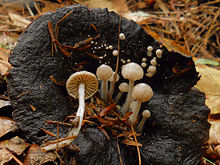
The Russulaceae are a diverse family of fungi in the order Russulales, with roughly 1,900 known species and a worldwide distribution. They comprise the brittlegills and the milk-caps, well-known mushroom-forming fungi that include some edible species. These gilled mushrooms are characterised by the brittle flesh of their fruitbodies.

Asterophora is a genus of fungi that grow as parasites on mushrooms. The genus contains four species, which have a widespread distribution, especially in temperate areas. The most recently described species, A. salvaterrensis, was found in Pinus pinaster forests in Galicia. Asterophora species are characterized by the massive production of chlamydospores in their fruit bodies and by the production of carminophilous lysosomes in their basidia. A frequently used but synonymous genus name is Nyctalis. The chlamydospores have been classified in the genus Ugola, which is an anamorphic name.

Russula is a very large genus composed of around 750 worldwide species of ectomycorrhizal mushrooms. They are typically common, fairly large, and brightly colored – making them one of the most recognizable genera among mycologists and mushroom collectors. Their distinguishing characteristics include usually brightly coloured caps, a white to dark yellow spore print, brittle, attached gills, an absence of latex, and absence of partial veil or volva tissue on the stem. Microscopically, the genus is characterised by the amyloid ornamented spores and flesh (trama) composed of spherocysts. Members of the related genus Lactarius have similar characteristics but emit a milky latex when their gills are broken. The genus was described by Christian Hendrik Persoon in 1796.

Lactarius torminosus, commonly known as the woolly milkcap or the bearded milkcap, is a large species of agaric fungus. A common and widely distributed species, it is found in North Africa, northern Asia, Europe, and North America. It was first described scientifically by Jacob Christian Schäffer in 1774 as an Agaricus, and later transferred to the genus Lactarius in 1821 by Samuel Frederick Gray. A variety, L. torminosus var. nordmanensis, is known from the United States, Canada, and Switzerland. L. torminosus officially became the type species of Lactarius in 2011 after molecular studies prompted the taxonomic reshuffling of species between several Russulaceae genera.
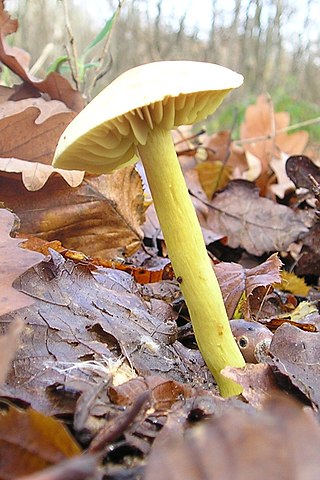
Tricholoma sulphureum, also known as the stinker, sulphur knight or gas agaric, is an inedible or mildly poisonous mushroom found in woodlands in Europe. It has a distinctive bright yellow colour and an unusual smell likened to coal gas. It occurs in deciduous woodlands in Europe from spring to autumn.

Russula adusta, commonly known as the blackening brittlegill or blackening russula, is a species of gilled mushroom. It is found in woodlands of Europe and North America. Russula adusta is a member of the Russula subgenus Compactae. The cap is brown to gray and somewhat shiny, with a mild taste and, reportedly, an odor of empty wine barrels. It has a propensity to turn black from cutting or bruising and has white spores. It can be found growing with conifers. Similar species include Russula albonigra and R. densifolia.

Lactifluus volemus, formerly known as Lactarius volemus, and commonly known as the weeping milk cap or bradley, is a species of fungus in the family Russulaceae. It is widely distributed in the northern hemisphere, in temperate regions of Europe, North America and Asia as well as some subtropical and tropical regions of Central America and Asia. A mycorrhizal fungus, its fruit bodies grow on the ground at the base of various species of trees from summer to autumn, either individually or in groups. It is valued as an edible mushroom, and is sold in markets in Asia. Several other Lactifluus mushrooms resemble L. volemus, such as the closely related edible species L. corrugis, but these can be distinguished by differences in distribution, visible morphology, and microscopic characteristics. L. volemus produces a white spore print and has roughly spherical spores about 7–8 micrometres in diameter.
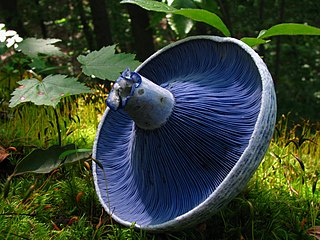
Lactarius indigo, commonly known as the indigo milk cap, indigo milky, the indigo lactarius, or the blue milk mushroom, is a species of agaric fungus in the family Russulaceae. It is a widely distributed species, growing naturally in eastern North America, East Asia, and Central America; it has also been reported in southern France. L. indigo grows on the ground in both deciduous and coniferous forests, where it forms mycorrhizal associations with a broad range of trees. The fruit body color ranges from dark blue in fresh specimens to pale blue-gray in older ones. The milk, or latex, that oozes when the mushroom tissue is cut or broken — a feature common to all members of the genus Lactarius — is also indigo blue, but slowly turns green upon exposure to air. The cap has a diameter of 5–15 cm (2–6 in), and the stem is 2–8 cm (0.8–3 in) tall and 1–2.5 cm (0.4–1.0 in) thick. It is an edible mushroom, and is sold in rural markets in China, Guatemala, and Mexico. In Honduras, the mushroom is called a chora, and is generally eaten with egg; generally as a side dish for a bigger meal.

Mycena polygramma, commonly known as the grooved bonnet, is a species of mushroom in the family Mycenaceae. The inedible fruit bodies are small, pale gray-brown mushrooms with broadly conical caps, pinkish gills. They are found in small troops on stumps and branches of deciduous and occasionally coniferous trees. The mushroom is found in Asia, Europe, and North America, where it is typically found on twigs or buried wood, carrying out its role in the forest ecosystem by decomposing organic matter, recycling nutrients, and forming humus in the soil. M. polygramma contains two uncommon hydroxy fatty acids and is also a bioluminescent fungus whose intensity of light emission follows a diurnal pattern.
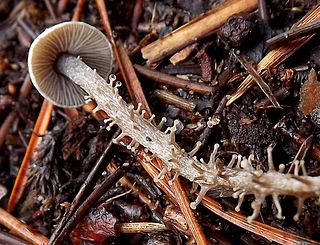
Dendrocollybia is a fungal genus in the family Tricholomataceae of the order Agaricales. It is a monotypic genus, containing the single species Dendrocollybia racemosa, commonly known as the branched collybia or the branched shanklet. The somewhat rare species is found in the Northern Hemisphere, including the Pacific Northwest region of western North America, and Europe, where it is included in several Regional Red Lists. It usually grows on the decaying fruit bodies of other agarics—such as Lactarius and Russula—although the host mushrooms may be decayed to the point of being difficult to recognize.

Lactarius pubescens, commonly known as the downy milk cap, is a species of fungus in the family Russulaceae. It is a medium to large agaric with a creamy-buff, hairy cap, whitish gills and short stout stem. The fungus has a cosmopolitan distribution, and grows solitarily or in scattered groups on sandy soil under or near birch.

Lactifluus deceptivus, commonly known as the deceiving milkcap, is a common species of fungus in the family Russulaceae. It is found throughout eastern North America on the ground in coniferous forests near hemlock or deciduous forests near oak, and in oak-dominated forests of Costa Rica. It produces large mushrooms with funnel-shaped caps reaching up to 25 cm (9.8 in) in diameter, on top of hard white stems that may reach 4–10 cm (1.6–3.9 in) long and up to 3 cm (1.2 in) thick. The gills are closely spaced together and yellowish-cream in color. When young, the cap is white in all parts, but the depressed center becomes dull brownish in age and breaks up into scales. The edge of the cap has a roll of cottony tissue that collapses as the cap expands. The surface of the stem—especially near the base—has a velvety texture. The mushroom "bleeds" a milky white acrid latex when it is cut or injured. Similar milk-cap species with which L. deceptivus might be confused include Lactifluus piperatus, L. pseudodeceptivus, L. caeruleitinctus, L. subvellereus, Lactarius arcuatus and Lactarius parvulus.

Lactarius vinaceorufescens, commonly known as the yellow-staining milkcap or the yellow-latex milky, is a poisonous species of fungus in the family Russulaceae. It produces mushrooms with pinkish-cinnamon caps up to 12 cm (4.7 in) wide held by pinkish-white stems up to 7 cm (2.8 in) long. The closely spaced whitish to pinkish buff gills develop wine-red spots in age. When it is cut or injured, the mushroom oozes a white latex that rapidly turns bright sulfur-yellow. The species, common and widely distributed in North America, grows in the ground in association with conifer trees. There are several other Lactarius species that bear resemblance to L. vinaceorufescens, but most can be distinguished by differences in staining reactions, macroscopic characteristics, or habitat.

Collybia tuberosa, commonly known as the lentil shanklet or the appleseed coincap, is an inedible species of fungus in the family Tricholomataceae, and the type species of the genus Collybia. Like the two other members of its genus, it lives on the decomposing remains of other fleshy mushrooms. The fungus produces small whitish fruit bodies with caps up to 1 cm (0.4 in) wide held by thin stems up to 5 cm (2.0 in) long. On the underside of the cap are closely spaced white gills that are broadly attached to the stem. At the base of the stem, embedded in the substrate is a small reddish-brown sclerotium that somewhat resembles an apple seed. The appearance of the sclerotium distinguishes it from the other two species of Collybia, which are otherwise very similar in overall appearance. C. tuberosa is found in Europe, North America, and Japan, growing in dense clusters on species of Lactarius and Russula, boletes, hydnums, and polypores.
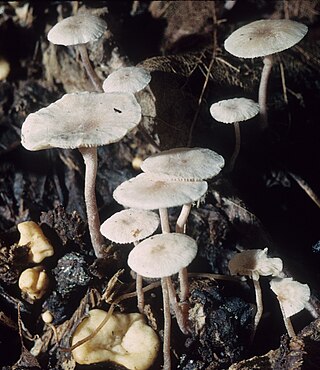
Collybia cookei is a species of fungus in the family Tricholomataceae, and one of three species in the genus Collybia. It is known from Europe, Asia, and North America. The fungus produces fruit bodies that usually grow on the decomposing remains of other mushrooms, like Meripilus giganteus, Inonotus hispidus, or species of Russula; occasionally fruit bodies are found on rich humus or well-decayed wood. The fungus produces small white mushrooms with caps up to 9 mm (0.35 in) in diameter, supported by thin stems that originate from a yellowish-brown sclerotium. The mushroom is difficult to distinguish from the other two species of Collybia unless an effort is made to examine the sclerotia, which is usually buried in the substrate. The edibility of the mushroom has not been determined.
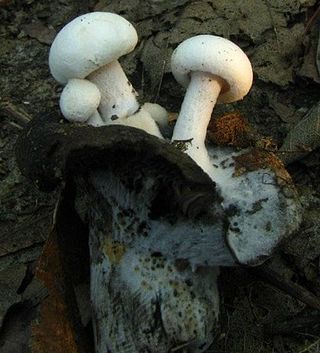
Asterophora lycoperdoides, commonly known as the star bearer, or powdery piggyback mushroom, is a species of fungus in the Lyophyllaceae family. It grows as a parasite on other mushrooms, mainly those in the genus Russula. Its gills are poorly formed or nearly absent. Asexual spores are produced on the mushrooms cap which enable the organism to clone itself easily. The spores are star-shaped, hence the name star bearer. It is regarded as nonpoisonous but inedible.

Hygrophorus purpurascens, commonly known as the purple-red waxy cap, is a species of agaric fungus in the family Hygrophoraceae. Its cap has a pink background color with streaks of purplish red overlaid, and mature gills have red spots.
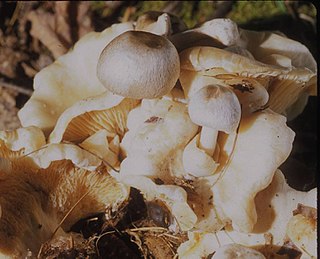
Volvariella surrecta, commonly known as the piggyback rosegill, is an agaric fungus in the family Pluteaceae. Although rare, the species is widely distributed, having been reported from Asia, North America, Northern Africa, Europe, and New Zealand. The fungus grows as a parasite on the fruit bodies of other gilled mushrooms, usually Clitocybe nebularis. V. surrecta mushrooms have white or greyish silky-hairy caps up to 8 cm (3.1 in) in diameter, and white gills that turns pink in maturity. The stipe, also white, is up to 9 cm (3.5 in) long, and has a sack-like volva at its base.

Russula densifolia, commonly known as the crowded russula or the reddening russula, is a species of agaric fungus in the family Russulaceae. It was first described in 1833 and given its current name in 1876. A widespread species, it is found in Asia, Europe, and North America, where it fruits on the ground in mixed and deciduous forests. Fruit bodies (mushrooms) are robust and squat, with caps up to 14.5 cm (5.7 in) in diameter, and stems that are 2–7.5 cm (0.8–3.0 in) long by 1.2–2.5 cm (0.5–1.0 in) thick. The mushrooms are characterized by the red and then black color changes that occur in the flesh when it is bruised, and a relatively thick cap cuticle. Although the mushroom is sold as an edible species in some areas of Asia, it is mild to moderately toxic, and may cause gastrointestinal upset if consumed. Several bioactive compounds have been isolated and identified from the mushroom.
Asterotremella albida is a species of fungus first described by C. Ramírez in 1957. It is also referred to as Cryptococcus ramirezgomezianus.
